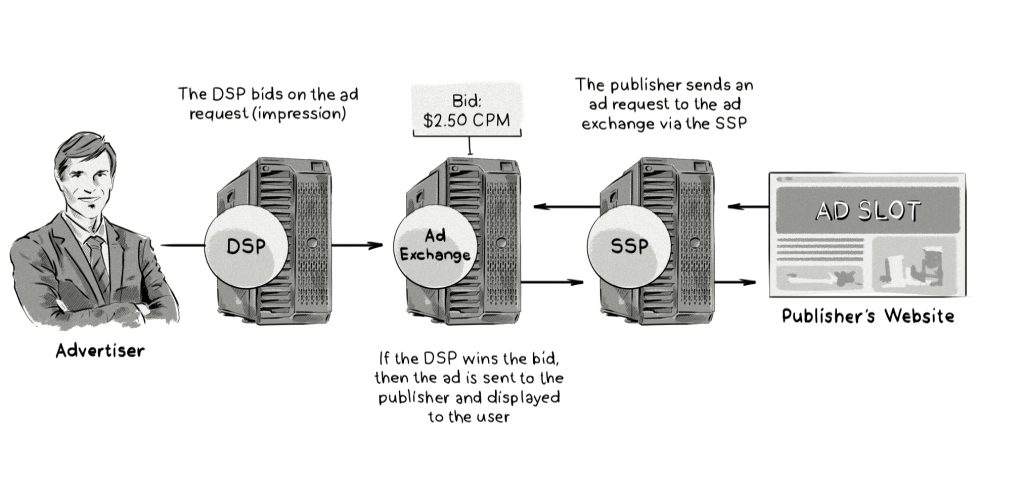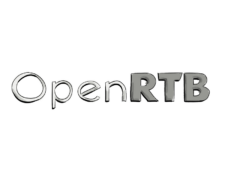Let’s imagine you open your web browser and enter a URL to access a website. The page loads, and you see a display ad on the right-hand side advertising a hotel you recently researched for your upcoming holiday.
How did the website know that you recently viewed this particular hotel?
This is an example of retargeting, which is just one small part of a much larger entity known as the online display advertising ecosystem.
There are a few ways users can be served an ad when visiting a website or using a web application, depending on the system the website’s owner (publisher) uses. The publisher could have a direct relationship with an advertiser and agree to display the advertiser’s ad on their website for a set price and a set amount of time, they could use an ad network and sell their inventory on a cost per thousand (CPM) basis, or they could utilize a highly effective, extremely beneficial and exciting process known as Real-Time Bidding (RTB).
The introduction of RTB has completely changed the way publishers and advertisers buy and sell display advertising.
The Main Components of the RTB Process
The RTB process is comprised of a number of platforms and systems within the display advertising ecosystem (e.g. ad servers, data management platforms, and third-party data providers), but for the purpose of this explanation, we are just going to focus on the relationship between the five main parties – the publisher, the supply-side platform (SSP), the ad exchange, the demand-side platform (DSP), and the advertiser.

The Publisher
In the context of display advertising, the publisher is the website that users visit. An example of a publisher can be something as simple as a travel blog or a news website, but can also cover web applications such as Facebook.
When a publisher decides to create a revenue stream through display advertising, they make ad space (ad slots) available on their website for potential content, known as inventory.
The Supply-Side Platform (SSP)
The supply-side platform is designed to help publishers sell their inventory on a number of different ad exchanges in an automated, secure, and efficient way. Even though publishers don’t need to use an SSP in order to sell their inventory on the ad exchange, the technology used in SSPs provides them with many benefits that allow them to receive the most yield from their inventory and gain clearer insights into their audience.
The Ad Exchange
Ad exchanges are dynamic technological platforms that facilitate the buying and selling process of available impressions between the advertisers (buyers) and the publishers (sellers) – very much like the way stock exchanges manage the buying and selling of stock between investors and companies.
We Can Help You Build a Demand-Side Platform (DSP)
Our AdTech development teams can work with you to design, build, and maintain a custom-built demand-side platform (DSP) for any programmatic advertising channel.
The Demand-Side Platform (DSP)
The demand-side platform is the advertiser’s equivalent of the supply-side platform used by publishers. The DSP stores display ads (a.k.a creatives) that the advertisers would like to appear on websites. They also provide many additional features that benefit the advertiser.
Some examples are:
Optimized media spending and conversions:
Many DSPs use advanced technology and algorithms to target specific audiences.
Avoiding fraudulent sites
With an estimated $6 billion stolen each year from advertisers via online advertising fraud, DSPs are working hard to identify and avoid malicious sites and ones that produce fake traffic generated by bots.
Transparency
More and more DSPs are providing media buyers with transparent reporting on media spend and conversions.
Reporting capabilities
By receiving analytics and detailed reporting capabilities, media buyers can gain clearer insights into their campaigns and make changes to improve conversions and maximize expenditure.
The Advertiser
At the other end of the spectrum lies the advertiser (or media buyer). Advertisers can be companies, or agencies representing a number of different companies.
The Real-Time Bidding Process
The whole RTB process begins when an Internet user accesses a website or web application. Right from the get go, the publisher’s site sends a message to the supply-side platform saying there is an impression available.
The supply-side platform analyzes the information about the user (location, web history, and, if available, age, gender and any other user information) and then sends this information to the ad exchange.
Once the ad exchange receives this information, it connects to the demand-side platforms and relays information about the user. The ad exchange starts an auction, and the DSPs then bid on the impression based on what that particular impression is worth to them – determined by predefined parameters set by the advertisers. The advertiser who bids the highest amount wins, and the bid is sent back to the publisher and displayed to the user.
This whole process is repeated for every available impression on a web page every time a user accesses a website, a new page, or refreshes the page.
From Selling to Sold in Under 100 Milliseconds
One of the most remarkable facts about RTB is the speed of the auctions in the ad exchanges – each transaction takes about 100 milliseconds (a 10th of a second).
To put that into perspective, it takes about 300 milliseconds to blink.
Thought that last fact was impressive? Here are a few more interesting facts about RTB and its future:
- In 2007, the three largest ad exchanges – DoubleClick, AdECN, and RightMedia – were all bought by Google, Microsoft, and Yahoo! respectively.
- It’s estimated that by 2017, more than 40% of total mobile and online display advertising will be RTB-based. (IDC)
- RTB will be the fastest growing segment of digital advertising in coming years, with global spending on RTB projected to reach $13.9b in 2016. (Ad Exchanger / IDC)
Programmatic advertising, RTB platforms, and ad technology are not only one of our main areas of expertise, they are also our passion. Learn more about our long-standing experience in the ad-tech field and view our successful projects by clicking here. If you have an ad-tech project idea you’d like to discuss, please contact us for a free consultation.
We Can Help You Build a Demand-Side Platform (DSP)
Our AdTech development teams can work with you to design, build, and maintain a custom-built demand-side platform (DSP) for any programmatic advertising channel.








